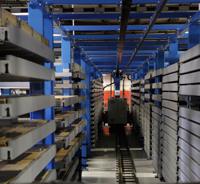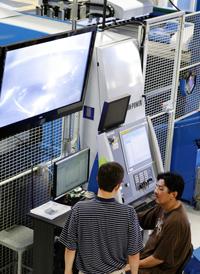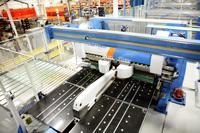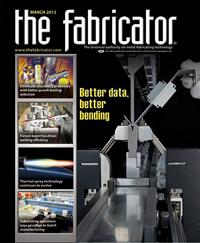Editor-in-Chief
- FMA
- The Fabricator
- FABTECH
- Canadian Metalworking
Categories
- Additive Manufacturing
- Aluminum Welding
- Arc Welding
- Assembly and Joining
- Automation and Robotics
- Bending and Forming
- Consumables
- Cutting and Weld Prep
- Electric Vehicles
- En Español
- Finishing
- Hydroforming
- Laser Cutting
- Laser Welding
- Machining
- Manufacturing Software
- Materials Handling
- Metals/Materials
- Oxyfuel Cutting
- Plasma Cutting
- Power Tools
- Punching and Other Holemaking
- Roll Forming
- Safety
- Sawing
- Shearing
- Shop Management
- Testing and Measuring
- Tube and Pipe Fabrication
- Tube and Pipe Production
- Waterjet Cutting
Industry Directory
Webcasts
Podcasts
FAB 40
Advertise
Subscribe
Account Login
Search
Out with the old batch, in with something new
Automated bending, cutting, punching, and material handling create a true JIT environment for Siemens Industry Automation
- By Dan Davis
- February 28, 2012
- Article
- Automation and Robotics

Figure 1: Avoiding or minimizing setup of any kind is an important part of maintaining high levels of productivity. To maximize throughput on its new Shear Genius punch/right-angle shear combination machine, Siemens Industry Automation maintains a fixed set of tooling on the machine and feeds as many parts as possible through it, taking full advantage of the system’s automated material handling.
Talking with John Hayden, a manufacturing engineering manager at Siemens Industry Automation Division, West Chicago, Ill., you might think you were talking to a member of Batch Manufacturers Anonymous. Before the summer of 2011, his company was dedicated to a build-to-order manufacturing approach, but the circumstances of the day led the fabrication department to create more work-in-process than was desired.
“What we had to do was very cumbersome. We had coil sheet that we would cut to length and then shear to width. You would then walk to a turret and punch it and then walk to a press brake and form it,” Hayden said, looking back at manufacturing life a little less than a year ago.
To balance responsiveness with a commonsense approach to manufacturing, Hayden and the 50 employees in the fabricating area typically produced parts that were not needed immediately. For instance, when a rush order for a door on one of Siemens’ motor control center (MCC) products came in, that order was run with however many of the same door fit on a 4- by 8-ft. blank. The other parts ultimately sat in inventory or were delivered to a kanban bin in assembly.
Additionally, Siemens was challenged with managing 30,000 different metal parts spread over its four product areas—MCCs, enclosed controls, switchboards, and solar inverters. Those doors, cabinets, and other parts were made from all kinds of material—hot- and cold-rolled steel; galvannealed and galvanized steel; stainless steel; and aluminum—in thicknesses from 7 to 18 gauge. Hayden and the fabricating team worked to minimize the WIP as it moved from the three turret punch presses and the eight press brakes. But to reach its goal of creating a true just-in-time fabricating environment that could support lot sizes as small as two and be truly lean without the workarounds, the fabricating team needed an automated helping hand.
The Summer of Installation
After almost two years of working on a plan to justify an investment in new fabricating equipment, Siemens Industry Automation Division received some timely support from Siemens Financial Services in late 2010 that enabled the division to make its automation investment.
The company had investigated several fabricating machine tool builders over the past several months as it looked at possibly purchasing capital equipment, but decided to go with one it had worked with previously. An older Finn-Power turret punch connected to a material tower had been a centerpiece of the fabricating operation, and Siemens personnel knew that the company, now known as Prima Power, had a material handling system that integrated nicely with the nesting software and new fabricating equipment. So the order was placed for the 250-shelf Night Train material handling system and the accompanying Shear Genius punch/shear, the LPe laser/punch, and the EBe Express Bender.
“The savings were there in order for us to justify the equipment,” Hayden said.
But before any installation could take place, engineers had to find room for the new equipment in the 160,000-sq.-ft. facility—while also allowing fabricating operations to continue. The plan called for moving inventory stock next door to a different 40,000-sq.-ft. building that Siemens occupied and using that freed-up space in the front of the building to relocate and run the older equipment.
By the time May 2011 rolled around, all of the concrete work was complete, and the rear of the West Chicago facility was ready for its makeover. The first of what would be 27 semi-trucks full of equipment and components of the material handling system arrived.
About three months later, all the pieces were in place—and the cut-to-length line and the shear were history.

Figure 2: The addition of an automated material handling system has eliminated plenty of inventory handling and management for Siemens Industry Automation. Manufacturing officials believe that the elimination of all of that material handling was the equivalent of gaining an extra shift’s worth of productivity.
Equipment in Action
The key to the new fabricating operation is the Shear Genius punch/right-angle shear combination machine (see Figure 1). Full 5- by 10-ft. sheets are fed into the machine from the material storage system and then punched and sheared. The parts are then offloaded for finishing or final assembly or moved onto a pallet for storage in the material handling system.
Deron Jackson, Siemens plant manager, said 85 to 90 percent of their custom-engineered products have to run through a turret punch press.
“We need the flexibility to be able to utilize a multitude of materials without setups. Having the [punch/shear] integrated into the entire material handling system was a huge upgrade. Today it is the workhorse, fabricating 60 percent of the material we produce,” Jackson said.
To illustrate the impact, Hayden referred to the 12-gauge door example again. Now when an order for that door type reaches the shop floor, the nesting software already has interfaced with the company’s enterprise resource planning system. As a result, the nest will contain that door and other 12-gauge parts that need to be processed for that day. The needed parts go to the automated bender or off-loaded so that they can be bent on one of the other three press brakes. The fabricating team estimated that the new equipment combination has resulted in a 20 percent scrap reduction compared to the old cut-to-length process.
Additionally, the shear can eat up skeletons rather quickly at the end of a job, creating easy-to-gather metal parts instead of awkward sheet remnants that have to be bent up and thrown away manually. It also eliminates nibbled edges on the part exteriors.
Of course, the heartbeat of the punching operation is the material handling system (see Figure 2). Operators no longer have to go anywhere to retrieve blanks; they are now delivered right to the machine.
Regarding raw material inventory, Hayden said, “We used to do a weekly cycle count to know how much material we had of all of the various types, thicknesses, and styles. Now this information is available online. We know exactly what material we have, how much we have, and where it is located.”
Hayden added that the combination machines and automated storage and retrieval system—not even operating at full capacity—have outpaced the work done by three of the old turret punch presses over a similar time period.
The LPe laser/punch (see Figure 3) is needed for those parts that don’t make sense for a punch press—items such as thick brackets and intricate smaller parts.
“We were surprised how quickly we got up to speed on this [laser/punch],” Hayden said. “We had a lot of experience with sheet metal part manufacturing and that made a big difference.”

Figure 3: The workers in the fabricating department of Siemens Industry Automation caught on quickly when it came to the new laser/punch combination machine. Even though it was the company’s first encounter with laser cutting, the machine operators soon had this and the other pieces of equipment running 24/7 after about 45 days.
The laser/punch combination machine alleviates some of the frustration typically associated with a single laser cutting machine, according to Hayden. For example, the nesting software has the punch create an entry hole for the laser, which eliminates splatter that the laser pierce can create.
“We Need This.”
The laser may have been new to a lot of workers at Siemens Industry Automation, but they likely were familiar with the technology from prior work experiences or general discussion with others in the industry. Automated bending, however, was truly a new experience.
“When we saw it in operation the first time, we said, ‘We need this,’” Hayden said. “Setup times eat so much of our press brakes’ capacity. It boggles my mind how quick setups are with the new bender.”
Setups now are measured in seconds instead of minutes. Backgauge positioning is automatic. Because NC servo axes, instead of hydraulic cylinders, control the actuations of the bending blade movements, accuracy is increased when compared to stand-alone press brakes. All material handling is automated, from the loading of flat punched parts, to the manipulation of the part in the bender, to the unloading of the finished product.
The machine is also a natural for those large parts that previously required two people to manipulate in a traditional press brake. The bender (see Figure 4) has a maximum bending length capacity of 100.39 in. and a maximum height of 8 in.
“Engineers used to challenge production to make things. Now equipment like this bender has the capability and functionality to challenge the engineers to come up with more complex solutions to assemble parts easier,” Jackson said.
For example, Siemens used to have to make some of its enclosures in three pieces—a top, a bottom, and a wrapper—because a nest on the 4- by 8-ft. sheet couldn’t accommodate one entire enclosure form. Now being able to work on a 5- by 10-ft. sheet and incorporating the automated bender, engineers can design an enclosure as one part and fit it on one sheet. This eliminates the need for welding or mechanical fastening.
Hayden said that engineers have been asked to look at all parts 6 in. or larger. (Parts have to be at least that big so that the bender’s clamping mechanism can grip the metal piece firmly.) In some instances, this may even call for adding some length to a part just so that it can be bent on the automated bender.
“We are just on the cusp of identifying those parts and moving them toward the automation,” Hayden said. “We have some low-hanging fruit that we’ll be able to realize as we head into next year.”
In the meantime, engineers have established a database where they can share information with other part designers. If something makes sense for one part as it is redesigned for the new automated fabricating equipment, it might make sense for other parts.

Figure 4: The automated bender has changed the way Siemens engineers design metal parts. In fact, if a part is larger than 6 in., it is reviewed to see if it can be redesigned to take advantage of the automation.
A Bright Fabricating Future
Hayden said he is excited about what awaits the Siemens manufacturing team. The fabricating department is buoyed by the investment made in the facility. Engineers and shop floor personnel are consulting each other to develop better part designs. All metal fabrication activities take place in-house; no one has to fret about quality or on-time delivery related to outsourced jobs.
If demand for the company’s products continues to grow, Siemens Industry Automation has prepared for it. The size of the material handling system can be doubled if needed.
That’s life as a reformed batch manufacturer. Siemens Industry Automation is fabricating parts only when needed, taking it one order at a time.
About the Author

Dan Davis
2135 Point Blvd.
Elgin, IL 60123
815-227-8281
Dan Davis is editor-in-chief of The Fabricator, the industry's most widely circulated metal fabricating magazine, and its sister publications, The Tube & Pipe Journal and The Welder. He has been with the publications since April 2002.
subscribe now

The Fabricator is North America's leading magazine for the metal forming and fabricating industry. The magazine delivers the news, technical articles, and case histories that enable fabricators to do their jobs more efficiently. The Fabricator has served the industry since 1970.
start your free subscription- Stay connected from anywhere

Easily access valuable industry resources now with full access to the digital edition of The Fabricator.

Easily access valuable industry resources now with full access to the digital edition of The Welder.

Easily access valuable industry resources now with full access to the digital edition of The Tube and Pipe Journal.
- Podcasting
- Podcast:
- The Fabricator Podcast
- Published:
- 04/16/2024
- Running Time:
- 63:29
In this episode of The Fabricator Podcast, Caleb Chamberlain, co-founder and CEO of OSH Cut, discusses his company’s...
- Trending Articles
AI, machine learning, and the future of metal fabrication

Employee ownership: The best way to ensure engagement

Steel industry reacts to Nucor’s new weekly published HRC price

How to set a press brake backgauge manually

Capturing, recording equipment inspection data for FMEA

- Industry Events
16th Annual Safety Conference
- April 30 - May 1, 2024
- Elgin,
Pipe and Tube Conference
- May 21 - 22, 2024
- Omaha, NE
World-Class Roll Forming Workshop
- June 5 - 6, 2024
- Louisville, KY
Advanced Laser Application Workshop
- June 25 - 27, 2024
- Novi, MI


























